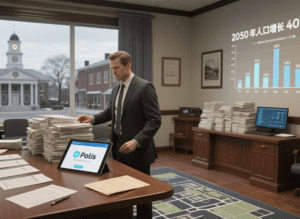
- From Empty Town Halls to a Radical Idea: AI’s Unexpected Impact
On a gray February morning in Bowling Green, Kentucky, Doug Gorman stared at a stack of unopened town hall sign-in sheets. The county judge executive had hosted three meetings that month to discuss the city’s looming population boom—by 2050, projections showed the area could grow by 40%—but turnout topped out at 23 people. “Mostly folks upset about new traffic lights,” he later recalled. “Hardly anyone talking about schools or parks or jobs.”
Across America, this was the norm: democracy reduced to the loudest voices in a room, while the silent majority stayed home, too busy with work or kids or skepticism to bother. But in Bowling Green, a radical idea was taking shape. What if, instead of chasing residents to town halls, the city brought the conversation to them—with a little help from artificial intelligence?
The result? A revolution in how communities talk to their governments. Over 33 days, nearly 8,000 residents—10% of the city’s population—weighed in on the future of their hometown, sharing 4,000 ideas and casting a million votes on each other’s proposals. When AI synthesized the data, the findings stunned everyone: Stripped of political labels and anonymity, Bowling Green residents agreed on 2,370 policies—80% of the ideas put forward. In a nation torn by division, a small Kentucky town had accidentally stumbled on a secret: Americans don’t disagree as much as we think.
- The Bowling Green Experiment: Democracy, Reinvented
How It Worked and Its Early Harvests
Bowling Green, Kentucky’s third-largest city, sits at a crossroads of tradition and change. Its downtown boasts a 19th-century courthouse and a thriving farmers’ market, but new subdivisions are sprouting on its outskirts, and the local university is expanding. By 2050, the influx of new residents could strain schools, roads, and healthcare—if leaders didn’t get ahead of the growth.
Gorman’s team knew the old playbook wasn’t working. Online surveys? They’d tried that, but the 500 responses were a jumble of typos, rants, and vague suggestions (“more stuff for kids”). Hiring interns to sort through it would take months. Then someone mentioned Pol.is, an open-source platform used in Taiwan to crowdsource policy ideas, paired with Sensemaker, an AI tool from Google’s Jigsaw that could analyze thousands of comments in hours.
The plan was simple: Launch a website where residents could submit anonymous ideas (“What should Bowling Green look like in 25 years?”) and vote on others’ proposals. The AI would sift through the noise, categorize themes, and flag areas of consensus. To reach everyone, the site offered 10 languages, from Spanish to Burmese, and worked on smartphones—critical for a city where 30% of residents lack reliable internet access at home.
Daniel Tarnagda, a Burkinabe immigrant who runs a local nonprofit, was skeptical at first. “My kids’ soccer team—they’re all immigrants, most don’t speak English well,” he said. “Town halls? They’d never go.” But when he showed them the multilingual site, something shifted. “A 16-year-old from Somalia typed, ‘We need a park where we can play soccer without getting chased by dogs.’ Within days, 80% of voters agreed.”
By the time the survey closed, the data painted a vivid picture of a community in harmony. Residents wanted more healthcare specialists so they wouldn’t have to drive an hour to Nashville for a cardiologist. They wanted empty strip malls turned into community centers. They wanted bike lanes connecting neighborhoods to downtown, and after-school programs for teens. “These weren’t partisan ideas,” Gorman said. “They were just… human ones.”
- AI as a Mirror: What Happens When We Stop Shouting?
How Technology Uncovered Hidden Consensus and Efficiency
The magic of Bowling Green’s experiment lay in how AI stripped away the baggage of modern discourse. On social media or at town halls, people default to tribes: “liberal” vs. “conservative,” “pro-growth” vs. “anti-development.” But on the anonymous platform, a teacher from a red district and a nurse from a blue neighborhood could both agree that “schools need more mental health counselors” without labeling each other.
Sensemaker, the AI tool, amplified this effect. It didn’t just count votes—it mapped connections. For example, it noticed that residents who cared about “green spaces” also strongly supported “expanding public transit,” creating a cluster of linked priorities. It flagged outliers (only 12% wanted to defund the library) and highlighted underrepresented voices: single parents, in particular, pushed for 24-hour childcare centers, a idea that gained sudden momentum once others saw it.
Yasmin Green, CEO of Jigsaw, called it a “democratic x-ray.” “We’ve built a politics of division, where algorithms reward outrage,” she said. “But here’s the thing: Outrage is noisy, but it’s not most people. AI let Bowling Green hear the quiet majority.”
The efficiency was staggering, too. What would’ve taken a team of volunteers 28 workdays to analyze—sorting through spreadsheets, categorizing comments, counting overlaps—the AI did in hours. By summer, a volunteer committee had turned the AI findings into concrete policies: a bond for new mental health clinics, a plan to repurpose a vacant Walmart into a community hub, and funding for bike trails.
- The Risks: Can We Trust AI With Democracy?
Concerns Over Bias and Privacy
Of course, not everyone was celebrating. At a city council meeting in July, a local retiree named Marsha Owens stood up, her voice shaking. “How do we know the AI didn’t pick and choose what it wanted to hear?” she asked. “What if it’s hiding disagreements to make us look united?”
Her fears weren’t unfounded. AI, after all, is only as good as its programming—and its programmers. Earlier this year, researchers found that Elon Musk’s Grok chatbot leaned on his personal opinions when answering sensitive questions. In civic engagement, such biases could be catastrophic: An AI trained on skewed data might downplay concerns from low-income neighborhoods or overemphasize the priorities of homeowners.
Privacy is another worry. Bowling Green’s site promised anonymity, but data breaches are common. What if a hacker leaked residents’ comments, exposing someone who criticized local officials? “We’re asking people to be vulnerable,” said Green. “If they can’t trust their words won’t be weaponized, they’ll stop speaking.”
- Beyond Bowling Green: A Blueprint for Unity
- The Experiment’s Ripples and a Look Ahead
Despite the risks, the experiment has ripples. Jigsaw recently partnered with the Napolitan Institute to replicate the model nationwide, polling residents in every congressional district on America’s founding ideals and future goals. Early results echo Bowling Green: On issues from infrastructure to healthcare, agreement runs deeper than cable news would have us believe.
Back in Kentucky, Gorman likes to tell the story of a town hall he hosted after the AI report came out. This time, 300 people showed up—not to argue, but to plan. “A guy from the Chamber of Commerce sat next to a teacher’s union rep and they brainstormed after-school job programs,” he said. “That’s the AI effect, I think. It showed us we’re all on the same team.”
As for the future? Bowling Green’s city council is set to vote on the AI-backed policies next month. If they pass, the first new mental health clinic could open by 2026. And Gorman? He’s already planning the next survey—this time, about climate change.
“In the end, AI didn’t solve our problems,” he said. “It just helped us hear each other. Turns out, that’s half the battle.”
In a divided nation, that might be the most stunning result of all.
What are the advantages of the automatic bearing assembly line?
Application cases of automatic bearing assembly lines




















